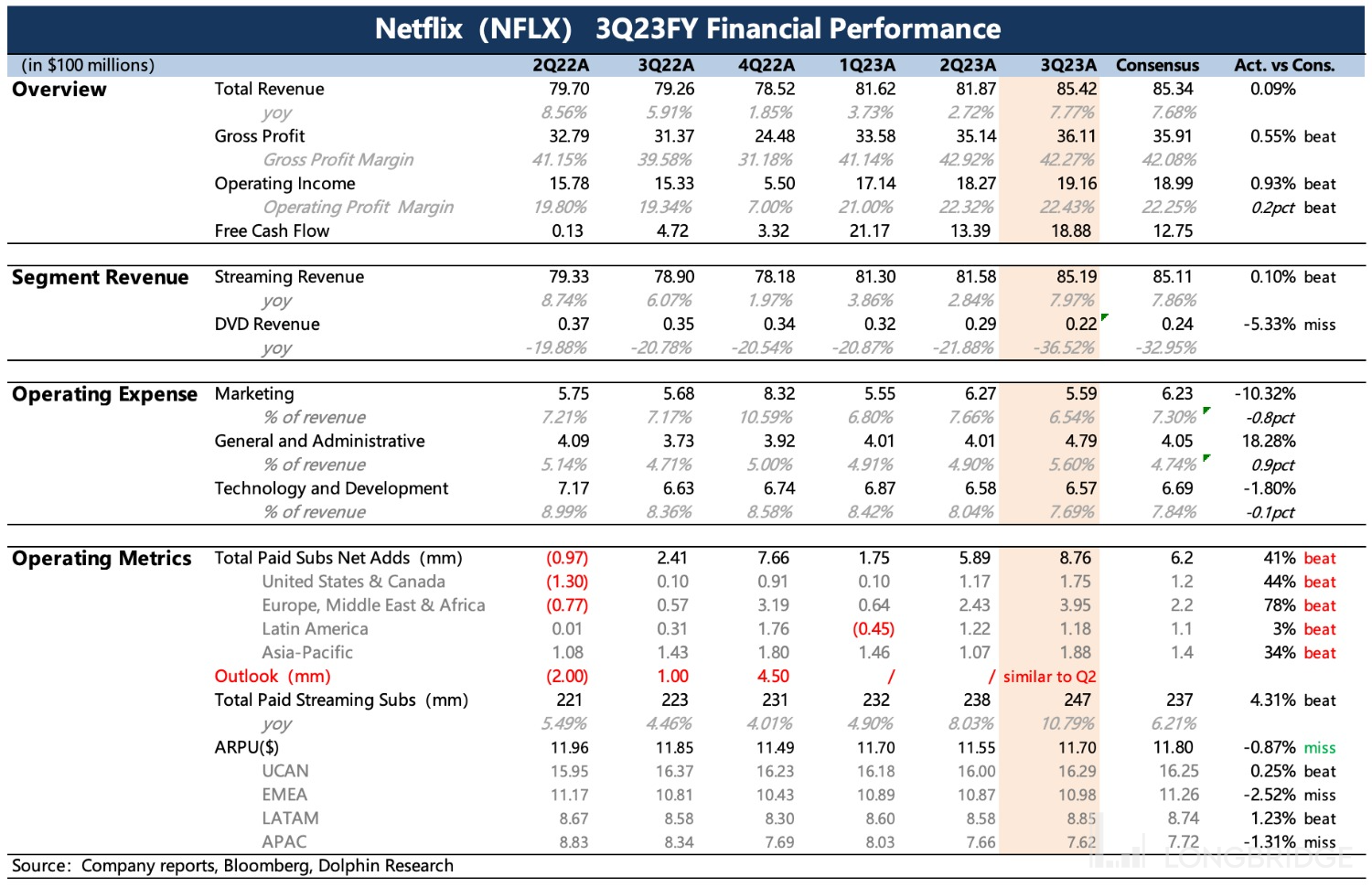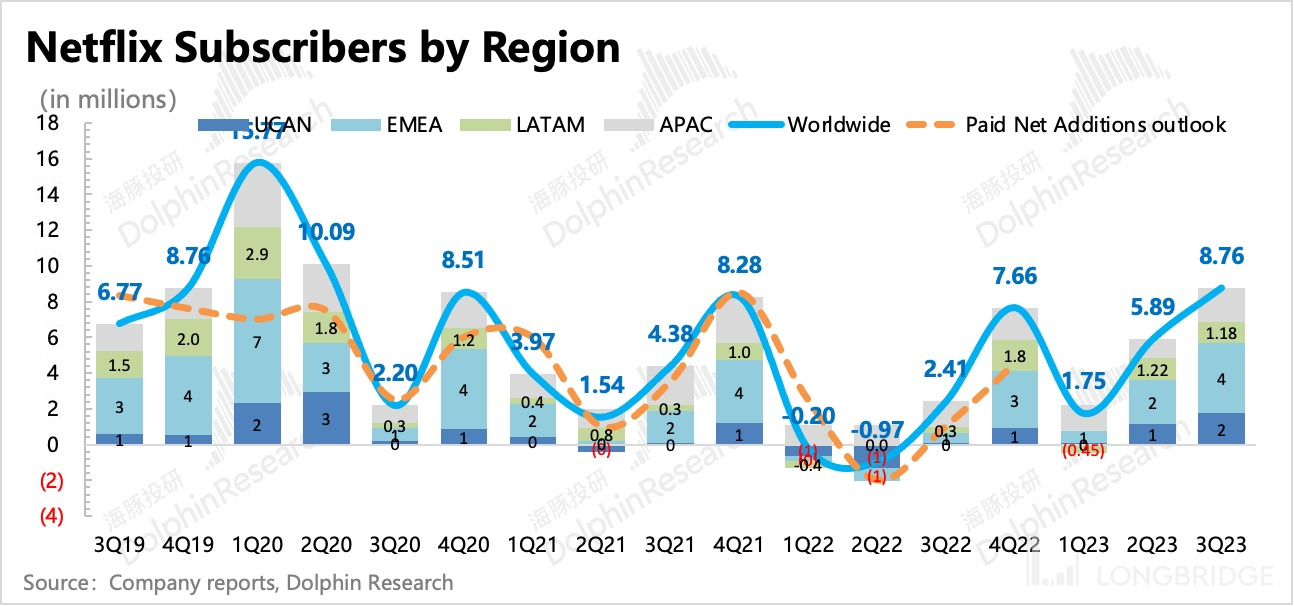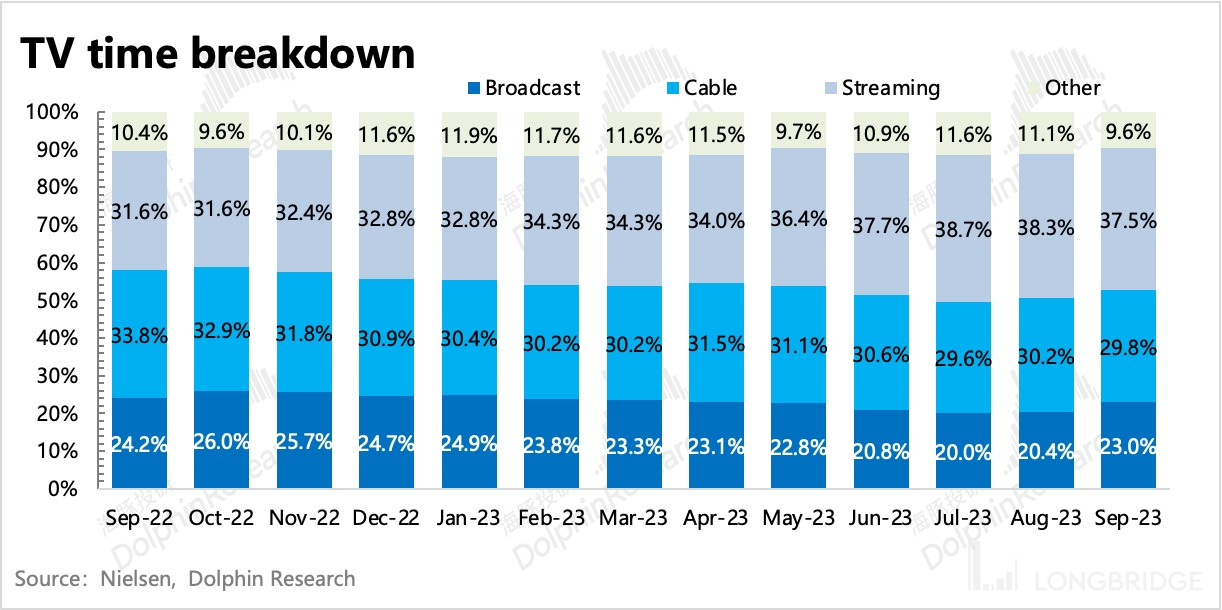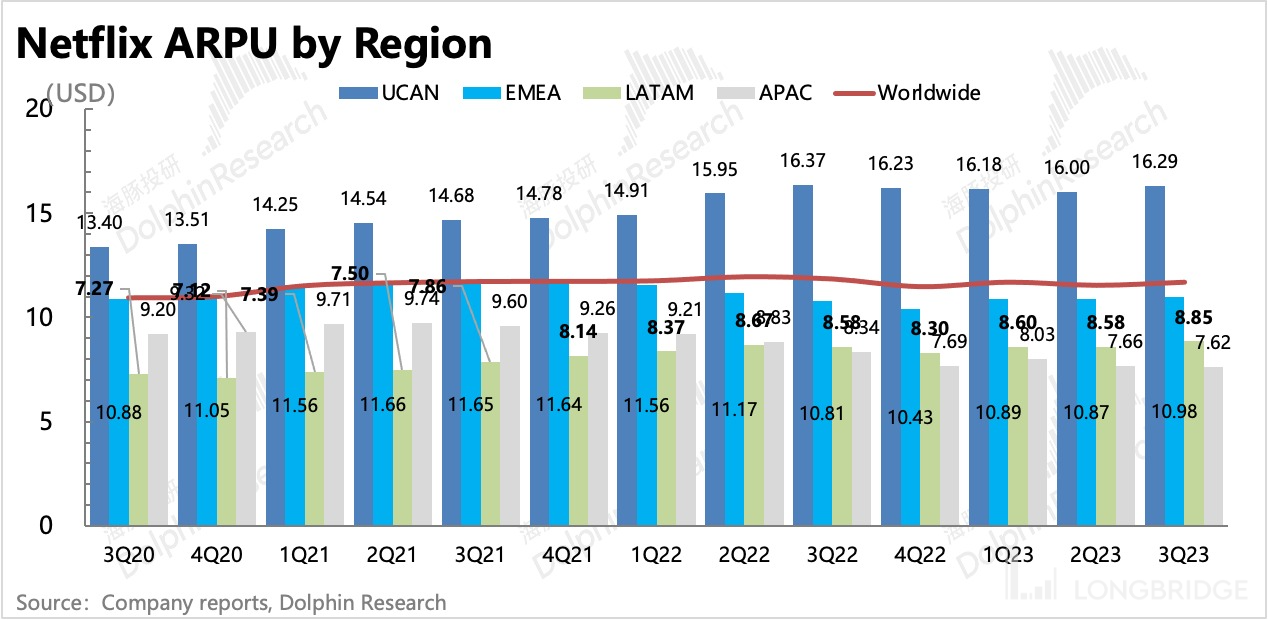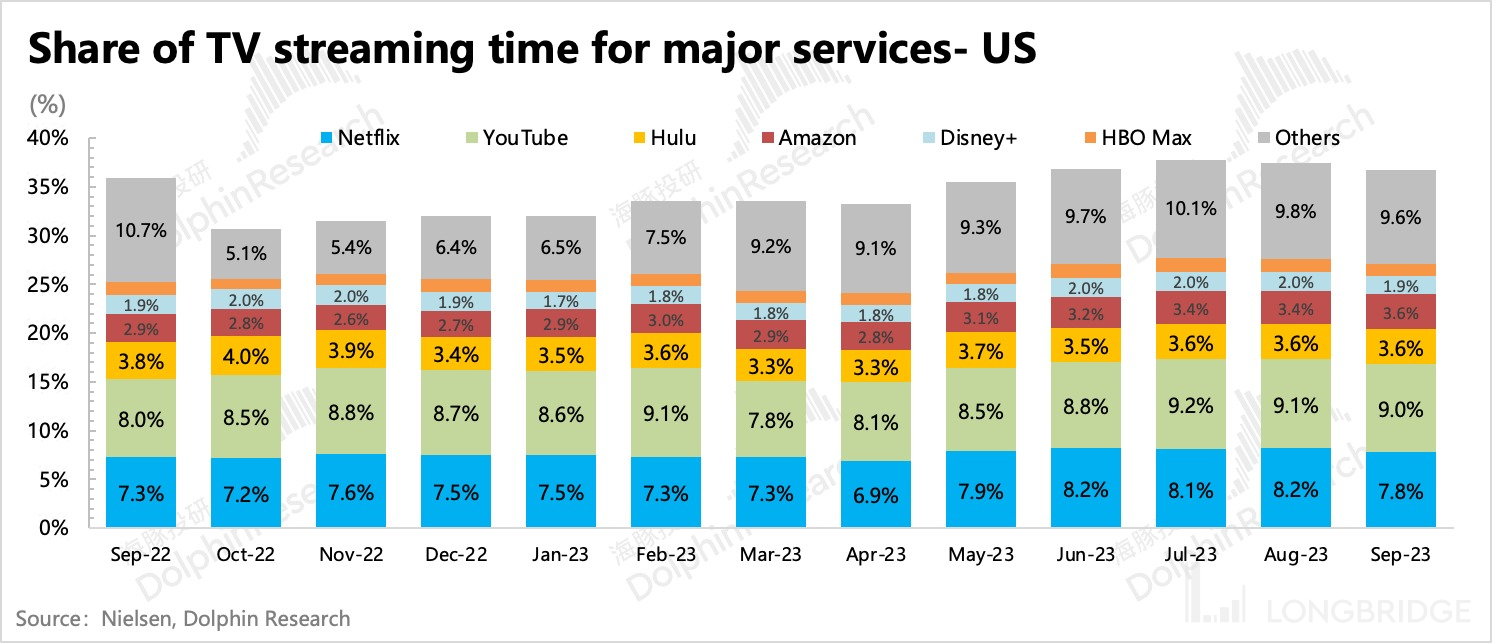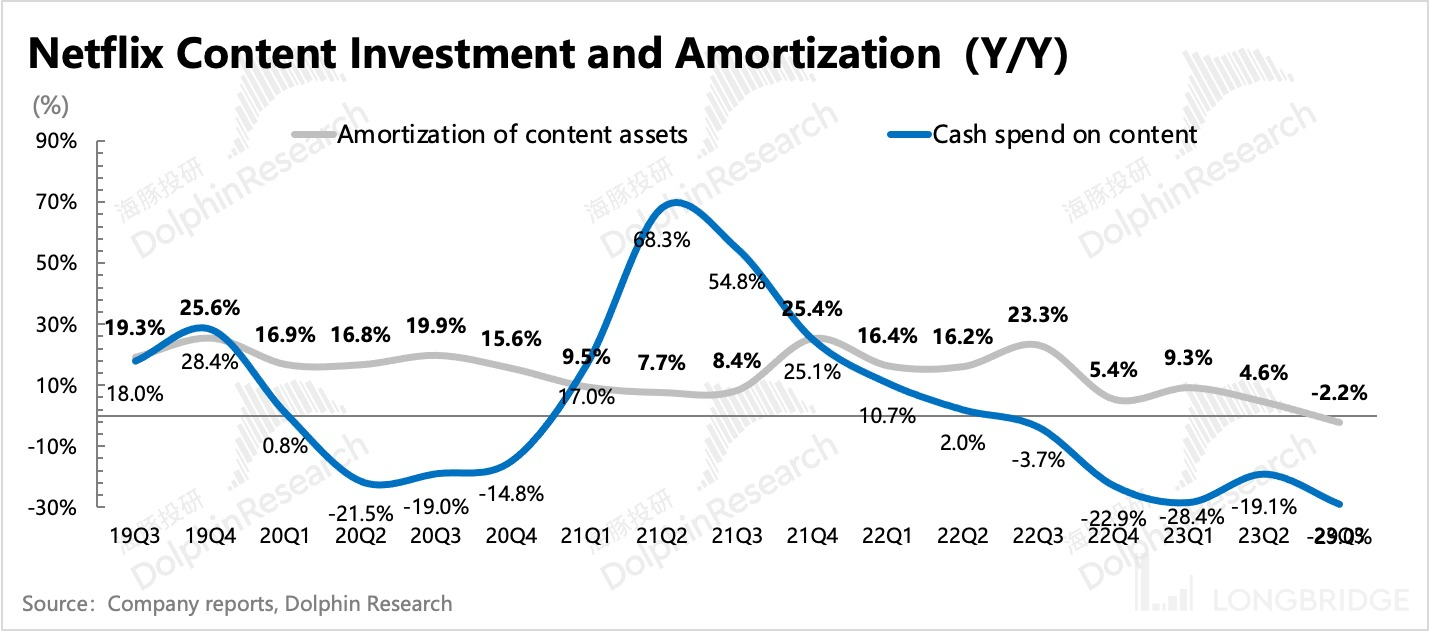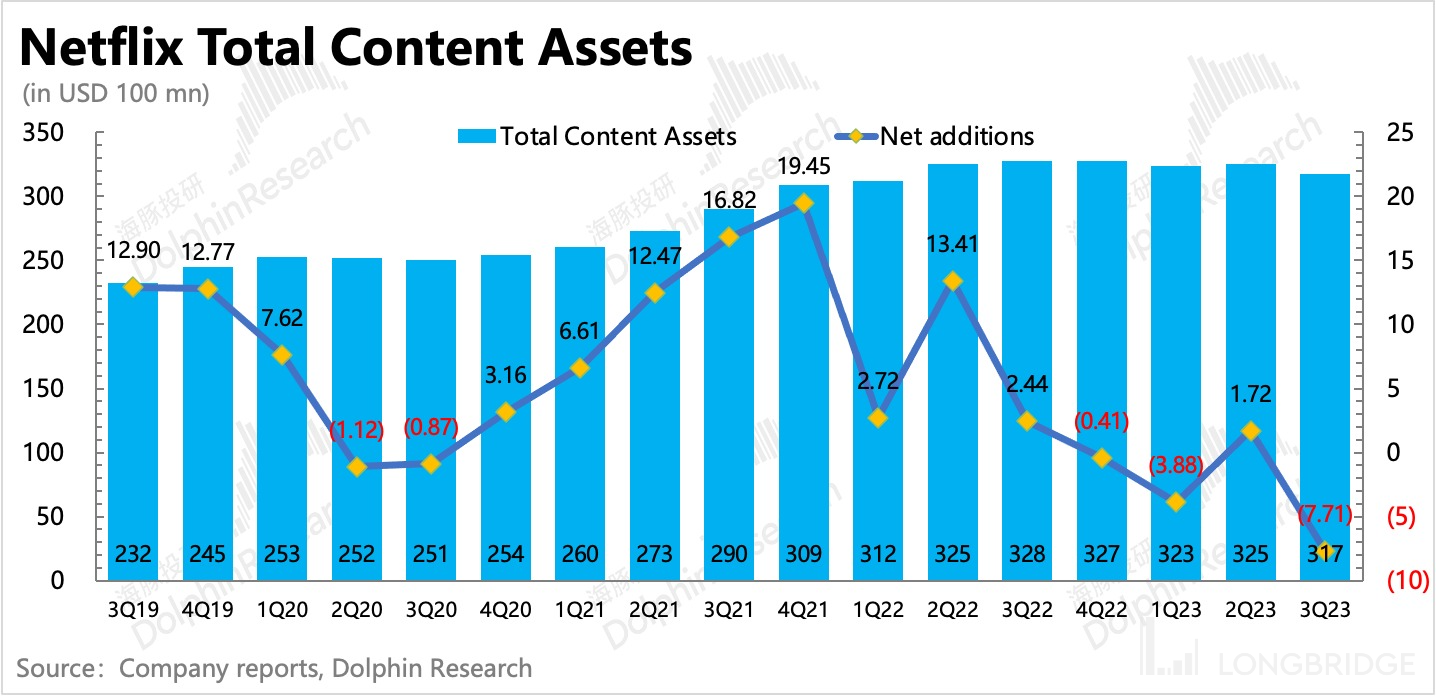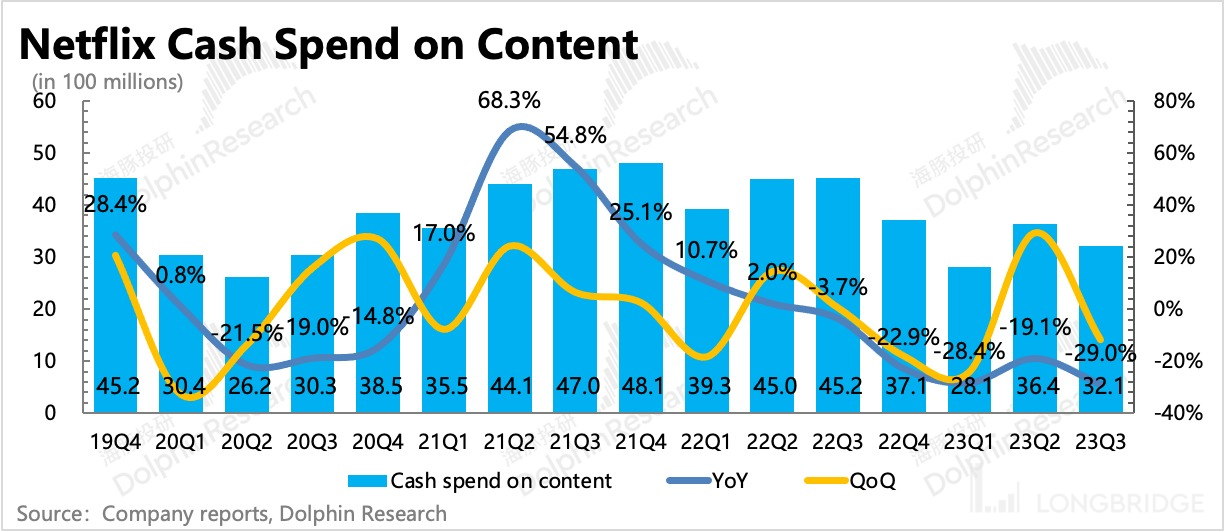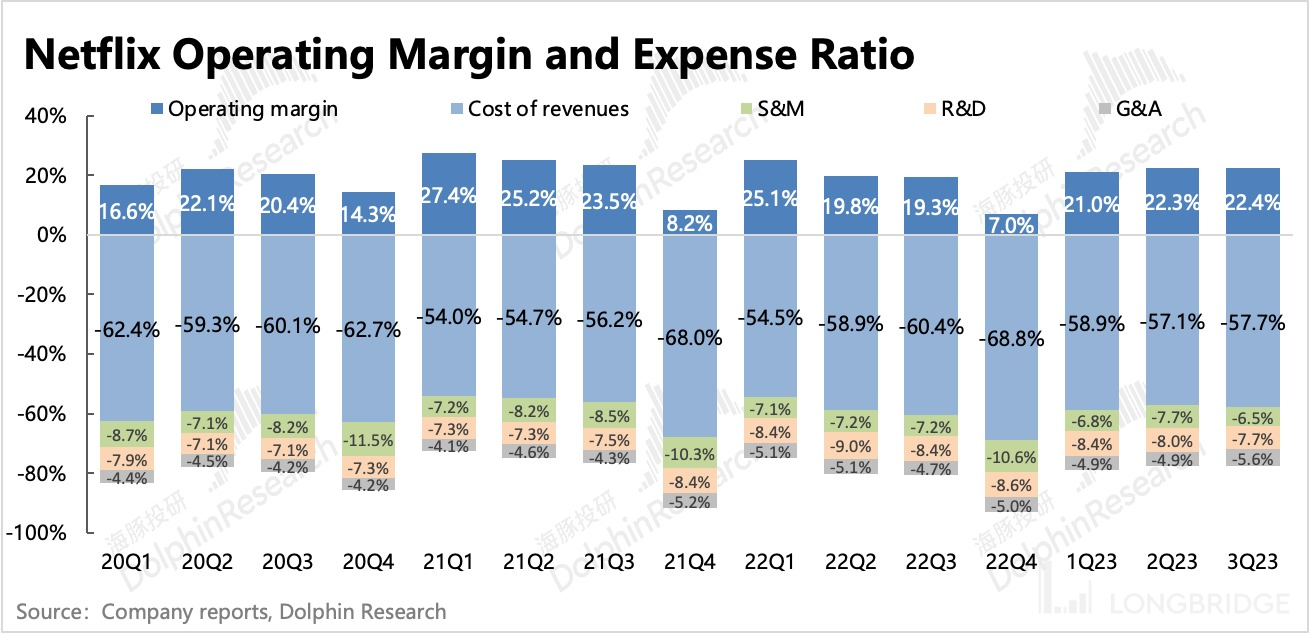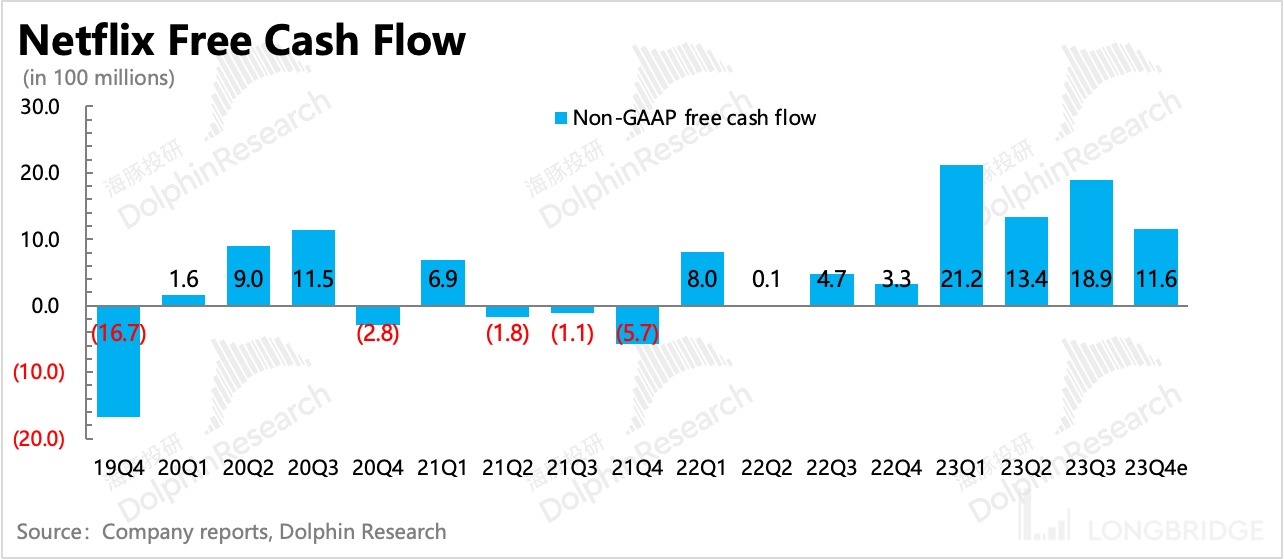
 Likes Received
Likes Received Posts
PostsGrowth questioned? Netflix raises prices in response

Netflix released its third-quarter earnings report for 2023 in the early morning of October 19th, Beijing time. In the third quarter, Netflix's subscriber count exceeded expectations once again, benefiting from the launch of account sharing restrictions and ad-supported plans.
However, what really excited the market (resulting in a 12% after-hours surge) were the multiple positive announcements made by management (guidance, buybacks, etc.). The most crucial among them, in Dolphin Research's opinion, was the announcement of upcoming price increases in key regions.
Specifically:
1)User growth exceeded expectations, and guidance was solid
Netflix added a net of 8.76 million subscribers in the third quarter, significantly surpassing the company's guidance (similar to Q2's net additions). While third-party app download data already indicated strong user growth, the actual growth performance of Netflix's account sharing restrictions strategy turned out to be better than market expectations.
No specific user guidance was provided for the fourth quarter, but management still estimated a net addition similar to Q3. If we estimate around 8-9 million, it would also exceed the market's Q4 expectations of 7.71 million net additions (BBG).
2)ARPU weakened YoY, but price increases are imminent
Currently, as the development of streaming platforms is believed to be approaching a plateau, the market pays more attention to changes in ARPU (average revenue per user).
The introduction of ad-supported plans and account sharing restrictions will have a more pronounced effect on user growth in price-sensitive but low-ARPU developing countries, thereby indirectly lowering the overall ARPU level.
As a result, starting from the previous quarter's revenue falling short of expectations, the market is more concerned about when Netflix will be able to resume price increases to drive overall revenue growth, especially in regions with higher revenue contributions such as Europe and the United States, where the last price increase was in early 2022.
When management explicitly mentioned in the shareholder letter that price increases are imminent in the United States, the United Kingdom, and France, it is no wonder that there was a strong after-hours reaction.
3)Expectations for continued revenue improvement
With user growth and a YoY decline in ARPU offsetting each other, Netflix achieved a 7.8% YoY increase in total revenue in the third quarter, which is not a high growth rate but is generally in line with market expectations. Looking at the MoM perspective, there is a clear improvement.
The company's outlook for the fourth quarter is more positive, with an expected YoY growth of 10.8%. Coupled with the potential impact of price increases, the market has higher expectations for a recovery in revenue growth.
4)Marketing and R&D expenses remain under control
In terms of expenses, Netflix remained relatively restrained in the third quarter, particularly in research and development and sales expenses, both of which saw a slight YoY decline, resulting in a maintained operating profit margin of 22.4%.Recently, in the management's public speeches, they mentioned that the expected increase in investment may affect profit margins, which caused some market concerns. However, the company has raised its operating profit margin guidance for the fourth quarter and next year, which has addressed some of the market's doubts.
5)Content investment rebound paused, continued focus on cash flow target, increased share repurchase limit
Although content investment rebounded in the previous quarter, it did not continue to increase in the third quarter. It seems that the company deliberately slowed down the new content investment cycle, resulting in better-than-expected free cash flow. At the same time, after raising the free cash flow target last quarter (from 3.5 billion to 5 billion for FY23), the management once again raised the target to 6.5 billion this quarter.
However, Dolphin Research believes that Netflix's control over content investment in the third quarter may not be a proactive choice. The Hollywood writers and actors strike lasted for more than five months, during which many projects were almost halted, resulting in a passive reduction in investment expenditure. With the signing of a temporary agreement, production companies have agreed to protect and even give concessions to writers and actors, which may also lead to an increase in content investment costs in the medium to long term.
This means that short-term cost control is not a long-term solution for profit growth, and revenue growth is still key. The company's guidance and price increase measures have released some confidence in returning to high growth, which is indeed what the market wants to see at present.
As of the end of the third quarter, Netflix's total debt was 14 billion, with little change compared to the previous quarter, maintaining the target leverage range of 10-15 billion. Net debt was 6.5 billion. In the third quarter, the company repurchased 6 million shares, using 2.5 billion in funds, which was significantly higher than the repurchase intensity in the first half of the year. As of the end of the third quarter, there is still 1 billion USD remaining in the previous repurchase plan. However, at the September board meeting, the company was approved to increase the repurchase plan by another 10 billion.
Dolphin Research's viewpoint
Netflix's third-quarter performance is mainly impressive in terms of guidance. Especially for the questions of "how to increase revenue" and "increased investment compressing profits," this earnings report provides a relatively clear answer to the market.
This also indicates that the lower-than-expected revenue in the previous quarter was more of a short-term fluctuation. As Dolphin Research mentioned at the time, it was just a case of high valuation, and the market would amplify negative feedback. As the streaming media industry gradually approaches a plateau period (with significantly slower growth), it is more important to increase user penetration than short-term efforts to achieve financial figures on revenue, given the intensifying competition trend.
With the continued expectation of high US bond yields, growth stocks have recently suffered significant declines, and Netflix has also wiped out a lot of valuation bubbles, just returning to Dolphin Research's neutral expectation (165 billion).
Compared with the current growth situation(digits growth), Netflix is not particularly cheap, especially after the after-hours rally today. Although this earnings report has indeed released some positive news, Dolphin Research also recognizes Netflix's fundamentals and core competitive advantages. However, in the context of high interest rates and potential weakening of consumer spending, chasing the rise at a non-safe price level still needs to be approached with caution.

The following is the detailed content:
1. Account sharing measures continue to be effective, and the number of subscribers exceeds expectations
In the third quarter, the net increase in subscribers was 8.76 million, exceeding the market's expected 6.2 million. The increase in users mainly comes from the measures taken to combat account sharing launched in more than 100 countries worldwide this year, as well as the better-performing advertising packages in emerging markets.
In terms of regions, the third quarter mainly came from Europe and the United States (account sharing crackdown) and the Asia-Pacific region (advertising packages). The subscription demand in the Latin American region was somewhat affected due to inflation and price increases.

There is still no specific user guidance for the fourth quarter, but management has stated that the net increase in the fourth quarter will be similar to that of the third quarter. If it is expected to be between 8 to 9 million, it will exceed the current market expectation of 7.7 million (BBG).
However, one concern in the market now is that the overall streaming media industry will gradually enter a plateau phase (slower penetration rate improvement) in the future. According to Nielsen's data, except for a quarterly decline in September (due to teenagers returning to school and the start of intensive sports events on limited TV channels), there was also a slight decline in August compared to July.
Dolphin Research believes that when the penetration rate is high, it is expected that the growth rate will slow down, but it does not mean that the plateau phase cannot grow. Netflix's introduction of measures to combat account sharing and advertising packages at this time is actually an implicit recognition that the stage of natural growth penetration has ended and some measures need to be taken proactively.
During the early stage of account sharing and low advertising conversion, it will definitely lead to a decrease in ARM single user revenue, thus affecting the growth rate of profitability to some extent.

2. With growth demands, price increases resume
In the third quarter, Netflix achieved a total revenue of 8.54 billion US dollars, a year-on-year increase of 7.8%, with a significant improvement on a quarterly basis.
In terms of segmented businesses, streaming media revenue (subscription + advertising) was 8.52 billion US dollars, a year-on-year increase of 10.8%, mainly driven by user growth; DVD business revenue accelerated its decline by 37% after the company announced its complete closure at the end of the third quarter, which can be ignored.
Due to concerns about revenue growth, the market has always hoped that Netflix can restart price increases in core regions as soon as possible. However, when the restrictions on account sharing were implemented in the second quarter, Netflix did not rush to raise prices in key regions due to short-term resistance from some users. Although there was a significant price increase in the Latin American region, it had limited impact on overall ARPU and revenue growth due to its low value, and it also suppressed the subscription demand of local users.

In addition, with the addition of new advertising package users, there are more users in the low ARPU Asia-Pacific region, which has led to a continued YoY decline in overall ARPU in the third quarter.

In order to meet the demand for growth, the management announced in the shareholder letter that it will immediately increase the membership prices in the United States, United Kingdom, and France (basic package and premium package). Dolphin Research believes that with the arrival of the content peak season and the maturity of the advertising business, it is expected that the ARPU in the fourth quarter will rebound to be flat or resume growth YoY.

3. Continuous competition in the streaming media industry, Netflix remains the leader
Competition in the streaming media industry has always existed, but due to the pressure from the overall environment, some followers/new entrants have made short-term adjustments to their operating strategies for this loss-making business. For example, cooperation between peers (Paramount and Showtime), reducing investment and increasing external content licensing (Disney), etc. Of course, there are also warriors with deep pockets who continue to fight aggressively (Amazon Prime).
Dolphin Research believes that with the pressure from the high-interest environment, competition within the industry is still slowing down marginally. There is an increase in cooperation and content licensing among the giants, and blind money burning has decreased. Some giants (such as Disney) have their own troubles and are more preoccupied with competition. However, Netflix's market share is still steadily increasing.
Looking at the data from Nielsen, after Netflix started sharing restrictions in May, its market share reached a new level and has remained relatively stable. In September, the market share declined to 7.8%, which may be related to the broadcast of multiple sports events. It is well known that Netflix does not have an advantage in sports content.
For Netflix, the strongest competitor in the industry is YouTube, especially when the conflict between Disney and Charter escalated and they blocked each other's content, causing a shift in user demand. Many cable TV operators are considering partnering with YouTube, which has more open content.

4. Pause in content investment rebound? Or short-term impact from strikes and profit demands
Dolphin Research has been mentioning in its earnings report reviews for the past few quarters that Netflix's content amortization has been increasing, but its content investment is accelerating its decline. When the scale of content assets started to decline on a quarterly basis last quarter, it indicated that Netflix's content investment may hit bottom and rebound.
However, in the third quarter, there was no continuation of the rebound trend despite the expected acceleration in content investment. In the third quarter, content investment expenditure was 3.21 billion, a year-on-year decrease of 29%, and the scale of content assets also showed a decline on a quarterly basis.
Does this mean that the new investment cycle has come to an end?


Dolphin Research believes that it is probably more of a short-term reason, and the trend will not change:
On the one hand, the 5-month-long Hollywood strikes undoubtedly had some impact on Netflix's content production progress, leading to a passive reduction in investment expenditure.
On the other hand, when the CEO came out and stated that he wanted to increase investment for growth, the market began to worry about the pressure on Netflix's profitability, especially the debt pressure under high interest rates. Therefore, investors chose to vote with their feet, causing a significant decline in Netflix's market value. It is not ruled out that the management actively reduced the investment budget in response to the demands for improved profitability and cash flow. In other words, although the investment cycle will enter in terms of growth rate, it will not be as aggressive as the previous two years.
Although the market is cautious about increasing investment, Dolphin Research believes that entering a new round of content investment cycle should be viewed positively in the long run. The current investment is for the future 1-2 years of content reserves, and only with abundant content reserves can the competitive advantage be more solid.

5. Improving profit margin and cash flow targets
In the third quarter, cost control continued, and the profit margin remained stable after a significant increase in the previous two quarters, although short-term impacts from the strike cannot be ruled out. In the third quarter, Netflix's operating profit margin was 22.4%, and the full-year operating profit margin guidance was 20%, which is the upper limit of the previous guidance range. In addition, management also expects to raise the operating profit margin target to 23% by 2024.

From Netflix's move to optimize its in-house animation project team last week, it is clear that the company is still actively reducing costs and improving efficiency internally. However, as we mentioned, content investment cannot be reduced in the long term, and preparations must be made early in the new investment cycle to ensure the future supply of content.Therefore, if we want to maintain profitability, it is crucial to increase revenue. This was also the point of concern in the market before, and it is the reason why Netflix has raised prices in its core regions.
In addition to aiming for higher profit margins, Netflix has also raised its target for free cash flow in 2023 from $5 billion to $6.5 billion, as a result of reduced content investment. It is expected that free cash flow in the fourth quarter will reach $1.2 billion, a YoY increase of 250%.
As a result, Netflix may have a significant amount of cash on its balance sheet. Therefore, in the third quarter, the company significantly increased its share buyback program, repurchasing $2.5 billion worth of stock, equivalent to 6 million shares. In September, the management added an additional $10 billion to the buyback program, which will be used for future repurchases. This can provide some support when the stock price is declining.

Dolphin Research "Netflix" Historical Articles
Earnings Season
July 20, 2023, Conference Call: "The Effect of Cracking Down on Account Sharing Will Further Emerge (Netflix 3Q23 Earnings Conference Call Summary)"
July 20, 2023, Earnings Review: "Netflix: Squeezed User Growth, Market Not Buying It?"
April 19, 2023, Conference Call: "Focus on the Prospects of Advertising and Account Sharing (Netflix 1Q23 Conference Call Summary)"
April 19, 2023, Earnings Review: "Hard to Beat the Freeloaders, Netflix Stuck in a Rut"
January 20, 2023, Conference Call: "Executive Changes Don't Affect Content Strategy, Advertising Revenue Target Above 10% (Netflix 4Q22 Conference Call Summary)"
January 20, 2023, Earnings Review: "Hit Shows Save Advertising, Netflix Perfectly Demonstrates 'Content is King'"October 19, 2022 Conference Call: Netflix: In addition to advertising, next year will focus on cracking down on account sharing (3Q22 conference call summary)
October 19, 2022 Earnings Report Review: Netflix: Soaring against the trend again, good content is the real "cure"
July 20, 2022 Conference Call: Advertising model is the new story of Netflix's future (conference call summary)
July 20, 2022 Earnings Report Review: Netflix: Performance didn't disappoint, but the carnival is unnecessary
April 20, 2022 Conference Call: Focus on how to increase revenue, actually "expose" the lack of confidence in user growth (Netflix conference call summary)
April 20, 2022 Earnings Report Review: A 25% overnight plunge, Netflix's logic collapses
January 21, 2022 Conference Call: Management says guidance expectations differ due to forecast uncertainty caused by the pandemic (Netflix Q4 earnings conference call summary)
January 21, 2022 Earnings Report Review: A 20% plunge? Netflix becomes a copycat of iQiyi
October 20, 2021 Conference Call: Ambitious Netflix's next goal is to learn from "Disney" (3Q conference call summary)
October 20, 2021 Earnings Report Review: Netflix: The return of the streaming media giant, accident or destiny?
July 21, 2021 Conference Call: Netflix Q2 conference call summary
In-depth Analysis
- February 16, 2022: "The Battle of Consumer Internet Giants: Meta, Google, and Netflix Fighting to the Death" (source)
- November 23, 2021: "The Coming Battle in Long-form Videos: Is Netflix Doomed in the 'American Version'?" (source)
Earnings Report Analysis
- July 21, 2021: "Earnings Report Review: Netflix's Continued Conservative Guidance, When Will the King Return in the Post-Pandemic Era?" (source)
- April 21, 2021: "Q&A from Netflix's Q1 Earnings Call: Insights into Management's Response to User Growth Concerns" (source)
- April 21, 2021: "Earnings Report Review: Netflix's User Growth Stumbles After the End of the Pandemic Dividend" (source)
Please refer to the Dolphin Research Disclaimer and General Disclosures for the risk disclosure and statement of this article.
The copyright of this article belongs to the original author/organization.
The views expressed herein are solely those of the author and do not reflect the stance of the platform. The content is intended for investment reference purposes only and shall not be considered as investment advice. Please contact us if you have any questions or suggestions regarding the content services provided by the platform.

